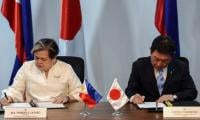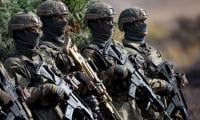Pakistan, China in pact to keep JF-17 tech away from US, India
BEIJING: China and Pakistan have a pact to keep the technology of their jointly-developed JF-17 Thunder multi-role combat aircraft away from the United States and India because of its superiority to America’s F-16 fighter jet, claims the Beijing-based Sina Military Network.The Block II variation of the JF-17, known as the
By our correspondents
September 21, 2015
BEIJING: China and Pakistan have a pact to keep the technology of their jointly-developed JF-17 Thunder multi-role combat aircraft away from the United States and India because of its superiority to America’s F-16 fighter jet, claims the Beijing-based Sina Military Network.
The Block II variation of the JF-17, known as the FC-1 Xiaolong by China, recently entered into service for the “Minhas” No2 squadron of the Pakistan Air Force (PAF). The new and improved configuration of the lightweight fighter jet is said to include improved avionics and better software, as well as a fixed air-to-air refueling probe.
Minhas is the third PAF squadron to be upgraded to the JF-17, which is expected to replace the F-7P, a Chinese-made fighter that can be equipped with C-802A anti-ship missiles.
The JF-17 features an aerodynamic shape similar to the US Navy’s F/A-18 and is powered by a high fuel efficiency Russian RD-93 afterburning turbofan. The aircraft’s flight performance is said to be far superior to that of second-generation fighters, with its climb rate, maneuvering speed and acceleration making up for a relatively low top speed of Mach 1.6.
While the RD-93 is not regarded as advanced given it was originally developed for the Soviet MiG-29 fighter, the engine is considered stable and reliable, with PAF Air Commodore Khalid Mahmood, head of the JF-17 sales and marketing team, adding that they have never experienced any problems with it after more than 7,000 hours of use.
Chinese engineers are reportedly continuing to look for ways to lighten the weight and streamline the aircraft. One new advancement is pairing an RD-93 with a so-called divergent supersonic air intake, which is said to be lighter, easier to maintain, and minimises the JF-17’s already low radar signals.
Recent photos of the JF-17 show the jet carrying two CM-400AKG high-speed air-to-surface missiles. Mahmood notes that the aircraft features flexible weapons stations that enable the JF-17 to be equipped with any weapon purchased on the open market.
Though the JF-17 can carry up to four SD-10 radar-guided air-to-air missiles, Mahmood states that the preference of the PAF is to use the space and weight for additional fuel tanks. The standard configuration of the JF-17 is therefore currently two SD-10s and two to three 1,000-litre external fuel tanks in addition to the 800-litre tank in the abdomen of the aircraft, he added.
According to the Sina Military report, expert comparisons between the JF-17 and the US F-16 have the Chinese-Pakistani aircraft dominating, adding that it is akin to a featherweight knocking out a heavyweight. The US has tried to get its hands on the JF-17 to analyse why that is the case but has been turned down by Pakistan because of a deal with China to never share the jet’s technology with the US or India, the report added.
The Block II variation of the JF-17, known as the FC-1 Xiaolong by China, recently entered into service for the “Minhas” No2 squadron of the Pakistan Air Force (PAF). The new and improved configuration of the lightweight fighter jet is said to include improved avionics and better software, as well as a fixed air-to-air refueling probe.
Minhas is the third PAF squadron to be upgraded to the JF-17, which is expected to replace the F-7P, a Chinese-made fighter that can be equipped with C-802A anti-ship missiles.
The JF-17 features an aerodynamic shape similar to the US Navy’s F/A-18 and is powered by a high fuel efficiency Russian RD-93 afterburning turbofan. The aircraft’s flight performance is said to be far superior to that of second-generation fighters, with its climb rate, maneuvering speed and acceleration making up for a relatively low top speed of Mach 1.6.
While the RD-93 is not regarded as advanced given it was originally developed for the Soviet MiG-29 fighter, the engine is considered stable and reliable, with PAF Air Commodore Khalid Mahmood, head of the JF-17 sales and marketing team, adding that they have never experienced any problems with it after more than 7,000 hours of use.
Chinese engineers are reportedly continuing to look for ways to lighten the weight and streamline the aircraft. One new advancement is pairing an RD-93 with a so-called divergent supersonic air intake, which is said to be lighter, easier to maintain, and minimises the JF-17’s already low radar signals.
Recent photos of the JF-17 show the jet carrying two CM-400AKG high-speed air-to-surface missiles. Mahmood notes that the aircraft features flexible weapons stations that enable the JF-17 to be equipped with any weapon purchased on the open market.
Though the JF-17 can carry up to four SD-10 radar-guided air-to-air missiles, Mahmood states that the preference of the PAF is to use the space and weight for additional fuel tanks. The standard configuration of the JF-17 is therefore currently two SD-10s and two to three 1,000-litre external fuel tanks in addition to the 800-litre tank in the abdomen of the aircraft, he added.
According to the Sina Military report, expert comparisons between the JF-17 and the US F-16 have the Chinese-Pakistani aircraft dominating, adding that it is akin to a featherweight knocking out a heavyweight. The US has tried to get its hands on the JF-17 to analyse why that is the case but has been turned down by Pakistan because of a deal with China to never share the jet’s technology with the US or India, the report added.
-
 Reese Witherspoon Issues Urgent Warning After Scammers Using Her Identity
Reese Witherspoon Issues Urgent Warning After Scammers Using Her Identity -
 XAI Restricts Grok Image Editing After Backlash From California And Europe
XAI Restricts Grok Image Editing After Backlash From California And Europe -
 ‘Disgraced’ Andrew’s Past Scandals Catch Up To His Daughters
‘Disgraced’ Andrew’s Past Scandals Catch Up To His Daughters -
 Amazon Rolls Out ‘sovereign’ EU-based Cloud To Address Data Privacy Concerns
Amazon Rolls Out ‘sovereign’ EU-based Cloud To Address Data Privacy Concerns -
 Ross, Matt Duffer Used AI To Write Finale Of 'Stranger Things'?
Ross, Matt Duffer Used AI To Write Finale Of 'Stranger Things'? -
 Microsoft Secures Largest Ever Soil Carbon Credit Agreement Amid Data Centres Expansion
Microsoft Secures Largest Ever Soil Carbon Credit Agreement Amid Data Centres Expansion -
 Google Expands Gemini With Personal Intelligence
Google Expands Gemini With Personal Intelligence -
 Japan, Philippines Sign Defence Pacts As Regional Tensions Escalate
Japan, Philippines Sign Defence Pacts As Regional Tensions Escalate -
 ISS Crew Of Four Completes Medical Evacuation With Safe Splashdown Off California
ISS Crew Of Four Completes Medical Evacuation With Safe Splashdown Off California -
 Connor Storrie Reveals Why His Dad Hasn't Seen 'Heated Rivalry' Yet
Connor Storrie Reveals Why His Dad Hasn't Seen 'Heated Rivalry' Yet -
 Meghan Markle’s Biggest Challenge In UK Return As She Struggles To Control Narrative
Meghan Markle’s Biggest Challenge In UK Return As She Struggles To Control Narrative -
 Princess Beatrice, Eugenie Angry As King Charles Ends Their Financial Security
Princess Beatrice, Eugenie Angry As King Charles Ends Their Financial Security -
 Chase Infiniti Shares Her Working Experience With Leonardo DiCaprio
Chase Infiniti Shares Her Working Experience With Leonardo DiCaprio -
 Todd Bridges And Wife Bettijo B. Hirschi Separate After Three Years Of Marriage
Todd Bridges And Wife Bettijo B. Hirschi Separate After Three Years Of Marriage -
 Germany Sends Troops To Greenland Amid Rising Arctic Tensions
Germany Sends Troops To Greenland Amid Rising Arctic Tensions -
 Jonathan Quick, The New York Rangers Face Mounting Pressure As Losses Pile Up
Jonathan Quick, The New York Rangers Face Mounting Pressure As Losses Pile Up



